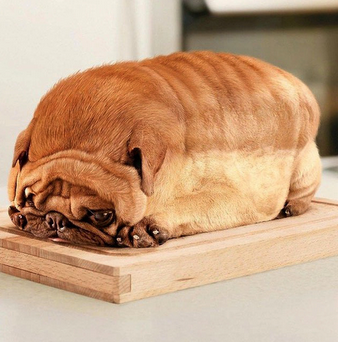Photographer: Jeremy Wong
PUGS LOVE FOOD!!!
Given the opportunity, a Pug will eat until every last kibble is gone or they explode. Whichever comes first!
It is your responsibility to make sure that your Pug does not get too heavy. Like people, Pugs who are overweight can develop heart problems, diabetes and problems with their legs and knees. In order to ensure that your Pug does not add on those unhealthy extra pounds, it is important that you feed your Pug a high quality dog food and that your Pug gets enough exercise.
A fourteen year landmark study confirms… finding and maintaining your dog’s ideal weight can significantly extend your pet’s life. Dogs fed to ideal body condition lived 1.8 years longer than their overweight litter mates.1 That’s a bonus of nearly 2 extra years of life… just for keeping your dog close to their ideal body weight. There’s no clear reference for every individual dog. Because dogs come in so many builds, shapes and sizes… how could there be? Yet you still need to have a target weight to shoot for.
Here’s a solution that works for all dogs…The Ideal Dog Weight System used by Veterinarians. The very best way to determine your dog’s ideal weight is to use the exact same method used by veterinarians… the Purina Body Condition System2.
The Body Condition System uses two simple techniques to rate the state of your dog’s body…
- Visual inspection
- Palpation (using the sense of touch)
By using your senses of sight and touch, you assign your dog to one of three categories…
- Too Thin
- Ideal
- Too Heavy
Your rating will be based upon comparing your dog’s appearance to a standardized diagram — and then palpating (feeling) for his ribs and frame.
Determining an ideal weight goal can make a real and measurable difference in how long your dog lives. Once you know that goal, it’s then important to serve the right amount each time you feed your pet. So be sure to estimate the right serving size for your dog. Be ready to change that amount whenever you switch to a different food. When deciding how much to feed your dog… never guess. Be scientific. Always calculate and measure.
Use our Dog Food Calculator and follow these three simple steps…
- Step 1 – Enter your dog’s ideal weight
- Step 2 – Select your dog’s life stage and activity level
- Step 3 – Insert your dog food’s “calories per serving”
Then, use a measuring cup or a scale… and feed the calculated amount.
Of course, keep in mind… results are approximate. Certain breeds and conditions may require some adjustment. And please remember… the calculator assumes your dog is at or near his ideal weight.
So, be flexible. If your dog appears to be overweight… or underweight… substitute something closer to “ideal” for your weight entry.
By the way… the calculator is for adult dogs only. Puppies require their own special feeding program.
Once again… never guess. Always measure each serving. And check your dog’s weight once a month or so. Over time, you’ll be glad you did.
Learn how to determine your dog’s ideal weight.
Here’s an easy way to weigh your dog.
Use our Dog Food Calculator to reveal your pet’s recommended serving size.
Sure, it’s a little extra work. But maintaining your pet’s ideal weight can be a very worthy goal.

